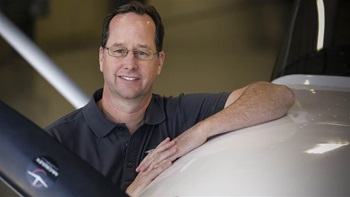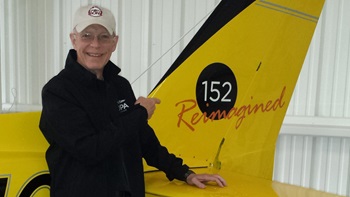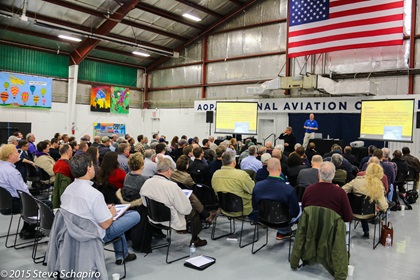When Tom Chandler, AOPA’s Central Southwest Regional Manager and a couple of other guys were talking about the need for a flying club in their area, one of the first things they did was attend a seminar about how to start a flying club that AOPA You Can Fly Ambassador Pat Brown was giving. It all began last fall when Rockwall Airport, about 25 miles east of Dallas, held an airport day. Tom set up a booth to represent AOPA and one of the people he spoke with asked questions about flying clubs. Then a second person asked similar questions. Those conversations were the start of forming a new club at the airport.
“We all had pretty similar needs and wants in terms of the aircraft we were interested in. So we met in November 2019, for the first time,” Tom said. “Pat was holding a seminar in Denton, Texas on flying club operations during the first weekend of December. All of us went to get educated on flying clubs.”
Although Tom has been around aviation for a long time as a professional pilot, CFI, and in airport management before joining AOPA a few years ago, he’s never been a member of a flying club. “It’s all fairly new to me. We’re just fortunate to have Pat as a resource,” he said. Pat is one of five Ambassadors around the country that work on the local level to help form flying clubs, hold Rusty Pilot seminars, and work with high schools that are interested in developing an aviation curriculum (see this month’s Resource Spotlight).
The other two gentlemen who are partnering with Tom are also new to clubs. One has been in the Civil Air Patrol for a number of years and has an understanding of aircraft operations from that experience and the other person is a fairly new pilot. The seminar they attended was called Maximum Fun, Minimum Cost: How to Start and Run a Flying Club.
One Seminar With Everything You Need To Know To Start A Club
The seminar starts with why people might want to join a flying club, explaining how a club spreads the cost of airplane ownership and operations over a number of people, which lowers the overall cost of ownership for all members. “We go through some simple arithmetic,” Pat said. “If you have a $100,000 airplane divided by 10 people that’s $10,000 apiece.” The seminar covers simple budgeting on how to determine fixed costs—expenses you are going to have whether the airplane flies or not, such has insurance, hangar or tie down, etc. It also looks at variable costs, such as fuel, oil changes, tires, avionics upgrades, engine reserve, upholstery, and paint. Determining these costs allow clubs to come up with monthly dues that cover the fixed costs, and an hourly rate for the variable costs.
An important part of budgeting is insurance. “There are two basic types of insurance. If you have a small number of members you can have a policy with up to five named members on the policy,” Pat said. “If you get more than four, and in some cases more than five depending on the underwriter, they’re going to bump you to a club policy, which is essentially a commercial policy, but with the lower risk of only named pilots flying the aircraft. One of the most important things the Ambassadors and Flying Clubs team suggest is to seek expert advice—talk with insurance brokers about your options, and when determining the corporate structure of your club, consult a local attorney as laws differ from state to state.
The seminar examines the pros and cons of different corporate structures, such as an LLC and a non-profit corporation, Pat said. “If you’re established as a non-profit corporation, you may apply for 501(c)(7) tax-exempt status as a social club.” For members who participate in AOPA’s Legal Services Plan, “there are a certain number of hours that are free of charge that you can redeem for help putting together various documents, so we encourage that,” he said.
Tom found the discussion about incorporation the most beneficial part of the seminar. “As an instructor over the years and operator of a small flight school, I understood the aircraft operations and the costs. But when it came to some of the legal structure options, that was really what I went in wanting to get, and I did,” he said.
The seminar wraps up with a discussion on how to find an airplane and what to look for during a pre-buy inspection. The presentation covers a lot of information in a short time. All of the topics are covered in depth in the AOPA’s Guide to Starting a Flying Club. “There’s a ton of stuff there—sample bylaws, sample SOPs (standard operating procedures), there’s sample articles of incorporation,” Pat said. “There’s sample lease documents if the club thinks about leasing an airplane. There’s all kinds of stuff there.” Tom added, “One of the great benefits of the AOPA Flying Club initiative is the way they get the information out there. I can’t imagine trying to put a club together without having all the information in one spot.” All of this can be found on the Flying Club Downloadable Resources webpage.
The Benefit of the Seminar
Tom expected to get a lot of useful information, but there were other benefits as well. “I learned a lot there. It was good to establish a ground level for all of us so there was a common level of knowledge,” Tom said. “Pat does a great job of answering all the questions and looking at all the options.”
Attending the seminar were three core club members and Pat introduced the group to another attendee who had a Cessna 150 and wanted to form a club. “That’s part of what Pat does, helping put people together to start forming these clubs,” Tom said. The150 owner also is an A&P mechanic so he was a natural fit to be a founding member along with Tom, who is a CFI. Armed with a good foundation of knowledge from Pat’s seminar and a talented group of founding members, the group decided to form a flying club around that Cessna 150.
Following the seminar, the group went to work hashing out issues like standard operating procedures and creating the groundwork for a strong safety culture. “I think that is one of the most important and probably challenging things—to make sure everybody has the same philosophy,” Tom said. “I think going to the (Maximum Fun, Minimum Cost) seminar gives you a chance to really clarify it, discuss it, and confirm that we’re all in the same spot. It’s important to make sure you’ve got the right folks to get the ball rolling and establish the right groundwork as you get the club set up.” The group has the paperwork in line but has not filed it yet because they’re still working on the aircraft ownership piece. They also have a few minor details to work out, like establishing a bank account and getting some initial financial commitments to pay things like fees to file the articles of incorporation.
Things Don’t Always Go As Planned – And That’s OK
Just as Tom and the other members had things pretty much nailed down, COVID-19 hit. “That caused everybody to back off and rethink things,” Tom said. “We’ve had some significant changes just in the past month.” One member’s mother passed away and he is considering leaving the area, and the owner of the Cessna got a job out of state, meaning they may have to rethink their first aircraft.
“I suspect this is pretty typical, especially because it’s taken a little time. Things change in people’s lives. All of our lives have changed, everyone is being flexible,” Tom said. “What we’re looking to do now is deal with these changes as they come along. I’m looking at maybe purchasing an airplane and we can just form the club at our own pace after that.” There’s a lot to forming a flying club and things won’t always go as planned. That’s normal, but it can be overcome. That’s the beauty of reaching out to an Ambassador, or AOPA’s Flying Clubs staff at headquarters. They have helped hundreds of clubs get started and have seen it all. They are an invaluable resource to help you navigate the process and pitfalls of forming a club.
In Pat’s experience with helping 23 clubs get started in Texas over the past four years, there will be people in the beginning that are excited to form a club and when it’s time to write a check, life issues may arise and they back out. “The most success I’ve had is when someone says I’m just going to buy an airplane and take a leap of faith,” Pat said. “Without exception those clubs have ended up with members and in some cases, long waiting lists.”
Tom’s goal is to start the club with about five members. “A big enough number for the finances to work out decently, but small enough to manage initially,” Tom said. The group has talked with a couple of people who have varying levels of interest. After the club gets launched and has some time to get going, they hope to get some more interest, so the club can expand to the point of justifying another airplane. “I think we’d all like to have access to a four-seater at the very least and maybe something a little quicker,” Tom said.
“For those who are not in a club but are thinking about starting one, it’s really not difficult,” Pat said. “There are some steps that have to be taken and decisions that have to be made, but overall it’s not a difficult process and AOPA makes it that much easier with the Ambassadors in the field and Flying Club Director Steve Bateman and Flying Club Manager Drew Myers, at Headquarters.”
Since the start of the Flying Clubs program, the team has help start more than 150 new clubs, and even despite the pandemic, initiative is well on the way to meeting its goal for this year.